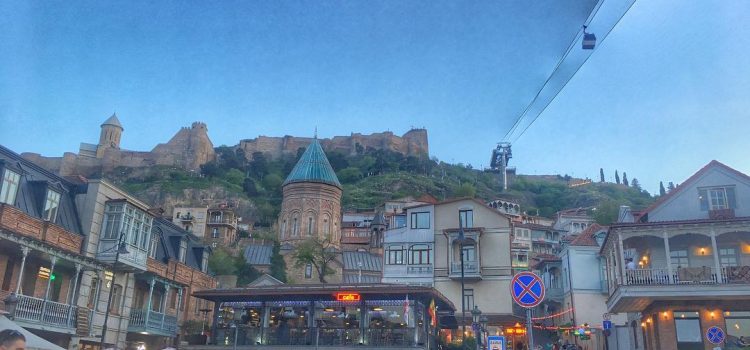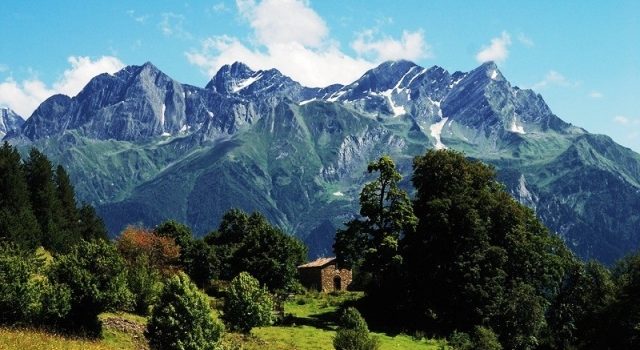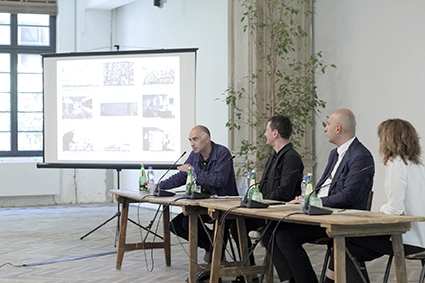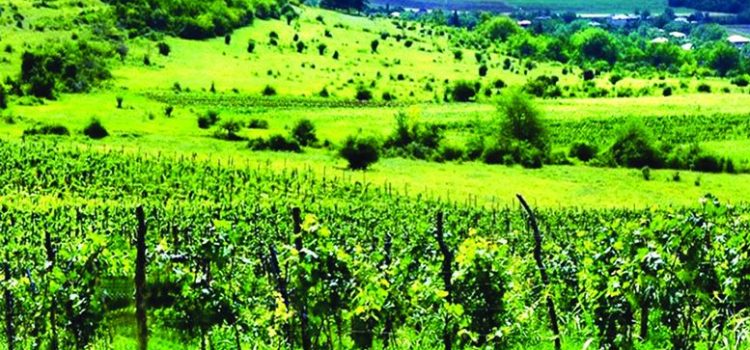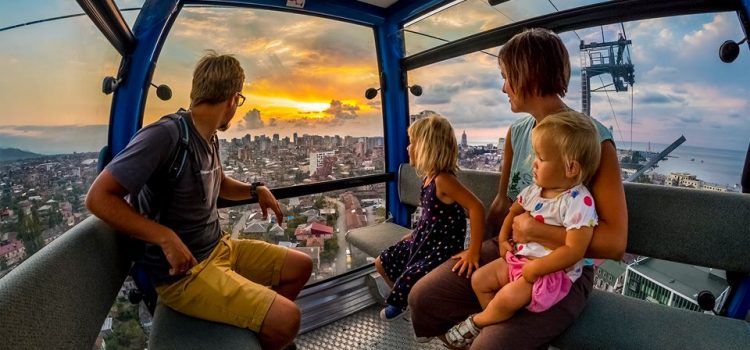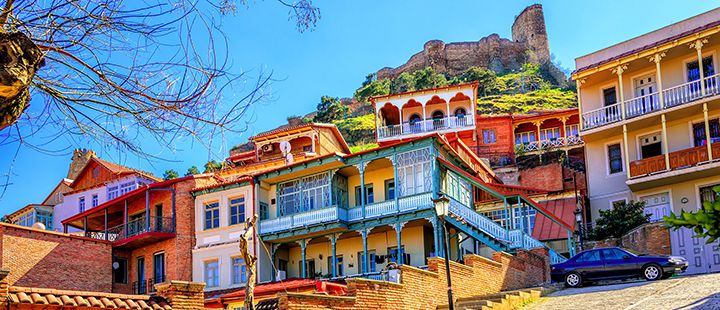World sights illuminated in the colors of the Georgian flag
Georgia celebrated the Independence Day on the 26th of May. The annual public holiday commemorates the 26 May 1918 adoption of the Act of Independence.26 May had been celebrated as a public holiday until Georgia became part of the Soviet Union in 1922.
Celebrations of regional public holidays were suppressed across the Soviet Union and it wasn’t until 1991, with the collapse of the Soviet regime that this day regained its public holiday status.
The government of Georgia organizes military parades, concerts, fairs, and various public events celebrating the history and culture of Georgia annually on Georgia’s Independence Day.
The famous landmarks around the world were illuminated in the color of the Georgian flag in order to commemorate the 101st anniversary of the country’s independence. The famous statue of Jesus on Mount Corcovado in Brazil, a historical bridge in Vilnius and the Christ’s Resurrection Church in Kaunas were illuminated on the 26th of May. According to the Ministry of Foreign Affairs of Georgia, the event will contribute to Georgia’s popularization across the world.
Besides, a concert and international cultural day took place in Stuttgart, Germany dedicated to the Independence Day of Georgia. The Georgian ensemble `Fesbebi` from New-York, Georgian Cultural center `Lazi` from Paris and the Georgian dancing ensemble `Medea’ from Antwerp along with various Georgian artists and musicians participated in the event.
The Georgian flag was festively raised, the anthems of Georgia and the USA and Georgian dances and songs were performed in Philadelphia in the commemoration of the Independence Day. The convention center was illuminated and the Georgian flags were showcased in the central part of Dublin, Ireland.
The Czech Republic hosted the performance of the Georgian ensembles and the exhibition of the Georgian national clothes. The festive events dedicated to the day took place in Denmark and Iceland as well.
source: Georgianjournal.ge; Photo: Georgianjournal.ge
Tour guides or foreign agents – what is happening in Georgia?
Nino Burchuladze and Nino Tsipuria, the journalists of Kviris Palitra, headed for the touristic centers of Tbilisi (the capital of Georgia) in order to find out more about the positive and negative sides of tourism in Georgia. They met tourists, local workers, vendors and listen to their views about the touristic situation in Tbilisi.
The first respondents were a group of Chinese tourists. They told the journalists that they liked Tbilisi and Batumi, a seaside city in south-western Georgia the most. According to them, Georgia is a well-known country in China. The only things they don’t like in Georgia are salty dishes and the lack of speedy trains. They hope Georgia and China will more deepen their relationship in the future.
Going up the Narikala fortress in Tbilisi, the journalists decided to have a conversation with local workers. They said that there are guides who fabricate stories about Georgia or provide wrong information to the tourists. They believe guides should be well-educated local people who have a good knowledge of Georgian history. There are various foreign touristic companies that don’t bring any financial profit to locals. They hope the government will impose certain regulations in this regard.
The next destination was the outdoor markets. The local vendors are impressed with the high number of tourists in Georgia. They hope it will increase in the summer. However, they are also concerned about the lack of Georgians’ involvement in local tourism. According to them, there are Arabian and Iranian guides who lie about Georgia saying that it is part of Iran or Saudi Arabia. As for tourists, they observed that Russian tourists have a very negative attitude and tend to look down on the vendors. The most positive and warm tourists are Ukrainians, Europeans, Arabians, and Americans.
Source: Georgianjournal.ge
New Museum to Be Launched in Oni
At the briefing, held prior to the Government meeting on May 23, the Prime Minister of Georgia Mamuka Bakhtadze stated that a new local museum is to be built in the town of Oni, Racha.
The Head of the Government focused on the importance of the development of the rural areas across the country and noted that providing appropriate infrastructure is vital in this case.
“Regional development is a major priority for us. It is the only way to achieve inclusive growth in Georgia. To ensure equal development in the regions of the country, it is important to put in place relevant infrastructure in each of them,” stated Bakhtadze.
The PM also accentuated the significance of the tourism industry for the general progress of Georgia.
“Tourism is the best sector for inclusive growth. We are developing relevant infrastructure in our mountain areas. This very goal is served by the Georgian Government’s decision to build a local museum in Oni,” he said.
The new multifunctional museum in Oni is planned to integrate a conference hall, an archive, a library, a multimedia library, as well as an educational space for minors.
source: www.Georgiatoday.ge; By Ketevan Kvaratskheliya
Image source: droa.ge
Art & Innovation Hub Opens in Tbilisi
This week, the Center of Contemporary Art – Tbilisi announced the creation of the first Art and Innovation Hub in Georgia.
At a press conference at Rooms Hotel on Monday, May 13, the Center of Contemporary Art – Tbilisi explained that the new Hub is being established in large part thanks to a new cooperation agreement with Adjara Group Hospitality, who agreed to a long-term transfer of property to CCA-Tbilisi to serve as the Center’s new home base. The press conference featured several presenters: Vato Tsereteli, founder of the Center of Contemporary Art – Tbilisi, Valeria Chekheria – CEO of Adjara Group Hospitality, Ana Riaboshenko – Director of Creative Georgia, and Levan Kharatishvili – Deputy Minister of Education, Science, Culture and Sport of Georgia. The speakers discussed the importance of supporting the development of creativity and the arts in Georgia.
The Center of Contemporary Art – Tbilisi is an independent, non-profit, community-based institution that serves as a station for people working in international, regional and local art scenes to connect and collaborate. The center aims to promote sharing and knowledge production among diverse populations, including art curators, artists, students and people simply interested in art. While the center emphasizes that education remains at the core of its work, they are also active in other realms: exhibition practice, research, residence programs and consulting.
2019 marks 10 years of the Center of Contemporary Art – Tbilisi, which implements public projects related to arts, culture, and education. During the press conference, the center took the opportunity to summarize their key projects from the last decade, and presented their plan for the future of the institution, including a reshaped strategy.
The creation of the Hub is financed in part with funds disbursed from a competition held by Creative Georgia titled “Developing Creative Industries.” The competition was run under the purview of the Ministry of Education, Science, Culture, and Sport. The funds will support the long-term development of the Art and Innovation Hub, which includes the creation of several clusters which will promote the sustainable development of creative industries, and innovative ideas and projects in the long-term. The Hub’s physical space, donated by Adjara Group, is a 650 m2 building on Dodo Abashidze St., near Marjanishvili metro station. The interdisciplinary project brings together leading innovators and bright young startups from various creative industries: fine arts, digital technologies, architecture, design, handicraft, gastronomy, and others.
Creative Georgia is a legal entity of public law within the Ministry of Education, Science, Culture, and Sport, tasked with creating an appropriate environment for creative industries to develop, via relevant programs, projects and grants. Their work is predicated on the concept that creative industries create jobs, and generate economic growth and social well-being. Creative Georgia works to raise awareness of creative industries; build the capacity of creative entrepreneurs though training programs, seminars and other activities; establish networking platforms; create funding opportunities and spread information about existing funding opportunities; support the export of creative goods and the internationalization of the sector; support the development of research activities in the creative industries sector.
Source: Georgiatoday.ge, By Samantha Guthrie
Image: Center of Contemporary Art – Tbilisi
30 Seconds to Mars to perform in Georgia
Thirty Seconds to Mars will visit Georgia this summer. Thirty Seconds to Mars is an American rock band from Los Angeles, California. The band was created in 1998 and consists of brothers Jared Leto and Shannon Leto. The concert will take place at Black Sea Arena in Shekvetili, Guria (located on the eastern Black Sea coast) on the 13th of August. The event is supported by Check in Georgia.
Thirty Seconds to Mars is not the only band who’s performing at Black Sea Arena this summer. Black Eyed Peas, an American musical group and Jessie J, an English singer, and songwriter will also visit Georgia. The Black Eyed Peas will perform on the 16th of June. As for Jessie J, her concert will take place on the 6th of August.
Source: Georgianjournal.ge, Photo: Georgianjournal.ge
Why Georgian-Danish couple prefers living in Georgia to the USA?
Eka Chvritidze and his Danish husband Olaf Malver own their wine company “Danieli Winery”. Eka had to pass a long way before launching a wine company.
Eka comes from Tusheti, Georgia’s mountain resort. She started to study at a Georgian school and then moved to the US. After finishing up the school in America, she managed to gain a 50% scholarship for a University. However, Eka knew she wanted to settle down in Georgia and came back. In Georgia, she graduated from the faculty of International Business and Foreign Trade at a local university and started working at one of the NGOs. This stage of life was a breaking point for her – she realized she’d better take care of cows and produce cheese in Tusheti than do tasks given by the boss.
Because of her Danish husband Olaf Malver, the couple had to live in California for 7 years. Olaf’s parents were collectors of French and Italian wines and he was also interested in wine production. Eka decided to make his dream come true and bought land in Georgia for a vineyard. In 2012, they returned to Georgia and a year later, they already started to produce wine. “Danieli Winery” produces Rkatsiteli, Kisi, Saperavi and qvevri wine.
The couple exports their wine to America, Ukraine, and Scandinavia. They do not plan to involve more countries but to focus more on quality.
Source: Georgianjournal.ge, Photo: Georgianjournal.ge
Great News: Black Eyed Peas will perform in Georgia
Black Eyed Peas, an American musical group will visit Georgia this summer. The concert will take place at Black Sea Arena in Shekvetili, Guria (located on the eastern Black Sea coast) on the 16th of June. The event is supported by Check in Georgia. Black Eyed Peas arrives in Georgia as a part of their “Masters of the Sun Vol. 1” studio album tour.
The Black Eyed Peas consists of rappers will.i.am, apl.de.ap, and Taboo. In the beginning, the group was established as an alternative hip hop group and subsequently changed their musical sound to pop and dance-pop music. The group has sold an estimated 76 million records (35 million albums and 41 million singles), making them one of the world’s best-selling groups of all time.
Check in Georgia covers series of cultural and sports events that will be held in Tbilisi and other regions of Georgia. The project will be held every single year and will become more and more diverse each time. The main goal of the project is to make Georgia a cultural center, during the year by attracting a large number of tourists.
source: Georgianjournal.ge
Why Tbilisi’s One of My Favorite Cities in the World
THERE ARE CITIES that make sense. The streets glide along straight, clean lines, their names uniform from start to finish. Bridges are crossable. Signs point in the proper direction.
Then there’s Tbilisi.
Riotous and anarchic, the capital of Georgia is anything but organized. Locals use Soviet-era street names—Leselidze, Davitashvili, Perovskaya—found only on decades-old maps. Wine is sold in repurposed Coca-Cola bottles for a dollar a liter from boulevard underpasses. The electricity still cuts out in the heart of the “Kala,” Tbilisi’s historic old town.
Despite this—maybe even because of it—this city is one of the best, most strikingly original travel destinations in Europe or Asia, if not the world.
Pop into an unmarked courtyard near the Armenian Norashen Church—overgrown with ripe pomegranates—and find yourself among well-fed stray cats in a bohemian artist’s studio (one of the workers may invite you for home-brewed, noxiously alcoholic chacha; he will not let you refuse, nor should you wish to).
Sneak into the basement of the red-brick seminary across from Sioni Cathedral and buy Tbilisi’s best bread—dough thrown against the scalding sides of a circular tone oven—from an elderly kerchief-wearing woman for 30 cents a loaf.
Head up a slanting set of town house stairs in the fin de siècle neighborhood of Sololaki and find yourself in a speakeasy-style apartment café called Linville, where tables hide behind vines on wrought iron balconies and afternoon tango milongas take place under decorative Victorian parasols.
Slip across the Dry Bridge, past the ruined frescoes of the former Grand Hotel, to the flea market and bargain with bearded ex-professors for wooden icons, Soviet-era gas masks, and Turkish tea glasses. Come more than once and the vendors will remember you (I buy my jewelry—traditional Georgian enameling—from the same seller every year; she recalls not just my taste, but that of the mother and grandmother I purchased gifts for).
The cliché, of course, is that Tbilisi represents the epitome of East meets West: a Silk Road crossroads where Arab, Ottoman, Mongol, and Russian imperial forces each left their own distinctive cultural mark. And in the heart of the old town, where rugs dangle from whitewashed wooden balconies and bearded Georgian Orthodox priests jostle with tourists on narrow cobblestone streets, it’s a compelling fantasy.
But the city’s reality is far more complicated—and intoxicating.
“East” and “West” are all but meaningless terms here, where the ancient fortress lording over old town has been used both by and against each set of conquerors, where the horizon—and the snowcapped Caucasus beyond—is punctuated by smoky Soviet tower blocks.
On Grishashvili Street, near the sulfur bathhouses—traditionally staffed not by ethnic Georgians, the by-far majority in this famously tolerant city, but by Muslim Azeris—a half-hidden chaikhana, or teahouse, serves baklava at carpeted banquettes before an open fire. A five-minute walk along the Kura River leads to Tartine—a French brasserie popular with expats and well-heeled locals alike—and café au lait delivered in gargantuan bowls. And at KGB, a restaurant whose tagline is “We’re still watching you,” Soviet kitsch takes on a hipster vibe.
Not all locals are as gleefully tongue-in-cheek about their city’s past, however. Shopping at the bazroba (bazaar), or feasting on caraway-spiced khinkali meat dumplings in wood-paneled working men’s taverns, you’re as likely as not to be dragooned into someone’s rhapsodic ode—in a mixture of Russian, Georgian, English, and fervently expressive gesturing—to the beauty of the mountains, the Virgin Mary, Mother Georgia, the tradition of hospitality, or women who happen to be in the vicinity.
Still, if Tbilisi has an aesthetic, it’s “retro collage.” Hidden bars like O Moda Moda—which doubles as a vintage clothing atelier—offer mulled wine and cocktails alongside traditional tarragon lemonade and syrupy Lagidze nectars served from massive soda fountains. Tbilisi’s most iconic eatery, Purpur, is a collection of mismatched tablecloths, 19th-century lamp shades, and crumbling flea market bric-a-brac.
But few places capture Tbilisi’s energy like the city’s hottest new restaurant, Café Littéra—brainchild of new celebrity chef Tekuna Gachechiladze—located in the palatial mansion that once housed the Soviet Writers’ Union. The food—chakapuli stew made with mussels instead of the traditional lamb, pomegranate-dusted river trout served a la tartare, classic badzhe sauce made, all but blasphemously, with almonds instead of the customary walnuts—reflects the best of Tbilisi’s breathless fusion culture.
Sure, the electricity might still go out at times.
But Georgians will light candles, shrug, and pour you another drink.
source: Nationalgeographic.com, by Tara Isabella Burton – regular contributor to National Geographic Traveler.
Half of New Construction Projects Located in Tbilisi
Fifty percent of construction permits granted in the first three months of this year are located in the capital city of Tbilisi, according to new data released by the National Statistics Office of Georgia (GeoStat).
A total of 2,052 permits were granted between January and March alone, with 7.8 percent more square meters planned, compared to the same period last year. Nearly three-quarters of the permits were issued in just three regions of Georgia: half in Tbilisi, 11.1 percent in Adjara and 10.5 percent in Kvemo Kartli. Racha-Lechkhumi and Kvemo Svaneti and Guria, two of the most sparsely-populated areas of Georgia, are home to only 0.3 percent and 1.6 percent of the planned projects, respectively.
As tourism to Georgia has blossomed in recent years, Tbilisi has subsequently exploded.
Andrea Basilaia, Head of Economic Development for the Tbilisi City Council, spoke to a group of British investors last October about the city’s economic potential.
He told investors that 7.9 million international tourists came to Georgia in 2017, 58 percent of which visited Tbilisi, yielding US$2.7 billion in revenue.
“Tourism is one of the main pillars at around 7% of Georgia’s GDP,” Basilaia noted. “The potential still big, so we’ll be developing new tourist attractions, as well as promoting and developing tourist infrastructure.”
He mentioned projects such as the renovation of the Tbilisi TV Broadcasting Tower, the proposed Tbilisi Theme Park near the Tbilisi Sea and Radio City, to be built on the site of a former Soviet radio factory north of the city.
source: Georgiatoday.ge by Lucy Papachristou
European heritage experts release report for David Gareji monument rehabilitation
European experts have published a report for rehabilitating David Gareji, one of the principal monuments of cultural heritage in Georgia, after it was named among Europe’s seven most endangered sites last year.
The report, presented by the Europa Nostra cultural heritage organisation, involves an assessment of the technical state of the monument and measures to be taken for its safeguarding from factors ranging from natural conditions to vandalism.
The release is a result of studies conducted by a Europa Nostra mission that worked closely with Georgian authorities and professionals during a visit to David Gareji in November and included experts of cultural heritage and financial support to rehabilitation projects.
Degradation of the physical structure and the artworks at the monument, along with vandalism and graffiti, was named as the main threat to the 22 rock-hewn monasteries and over 5,000 sanctuaries and cave-cells that comprise David Gareji, located on Georgia’s south-eastern border with Azerbaijan and partly extending over it.
The experts also noted unlawful practices, including taking souvenirs from the 6th century CE site and leaving graffiti on its surfaces, as contributing factors to its degradation.
Recommendations outlined by the team of professionals said the number of distinctive sites at the monument — and limited resources available to rehabilitate them — meant prioritisation of the most at-risk cave sites would be necessary.
Structural stability of “each cave site, or lavra” will require assessment through “geo-structural analysis”, while safe access to selected sites will be needed to set up security systems both for monitoring their geographical stability and safeguarding them from vandalism-motivated intrusions.
The report also includes a need for a “command structure” and a “steering committee” for overseeing the above-mentioned measures for safeguarding David Gareji.
Finally, the experts recommend setting up a visitor centre and a museum near the site to service the “increasing flows” of visitors and present exhibits discovered at the monument — instead of having them preserved at Tbilisi museum venues 70km away, as is currently the case.
The full technical and financial report for rehabilitating David Gareji can be accessed here.
Known formally as the David Gareji Monasteries and Hermitages, the site was named in Europa Nostra’s 7 Most Endangered programme last year, with the selection highlighting the seven monuments across Europe that face risks of disintegration or decay.
The Georgian site was nominated for the list by the Georgian Arts and Culture Centre, which represents the country in Europa Nostra.
Source: Agenda.ge; Photo: Georgiatoday.ge


